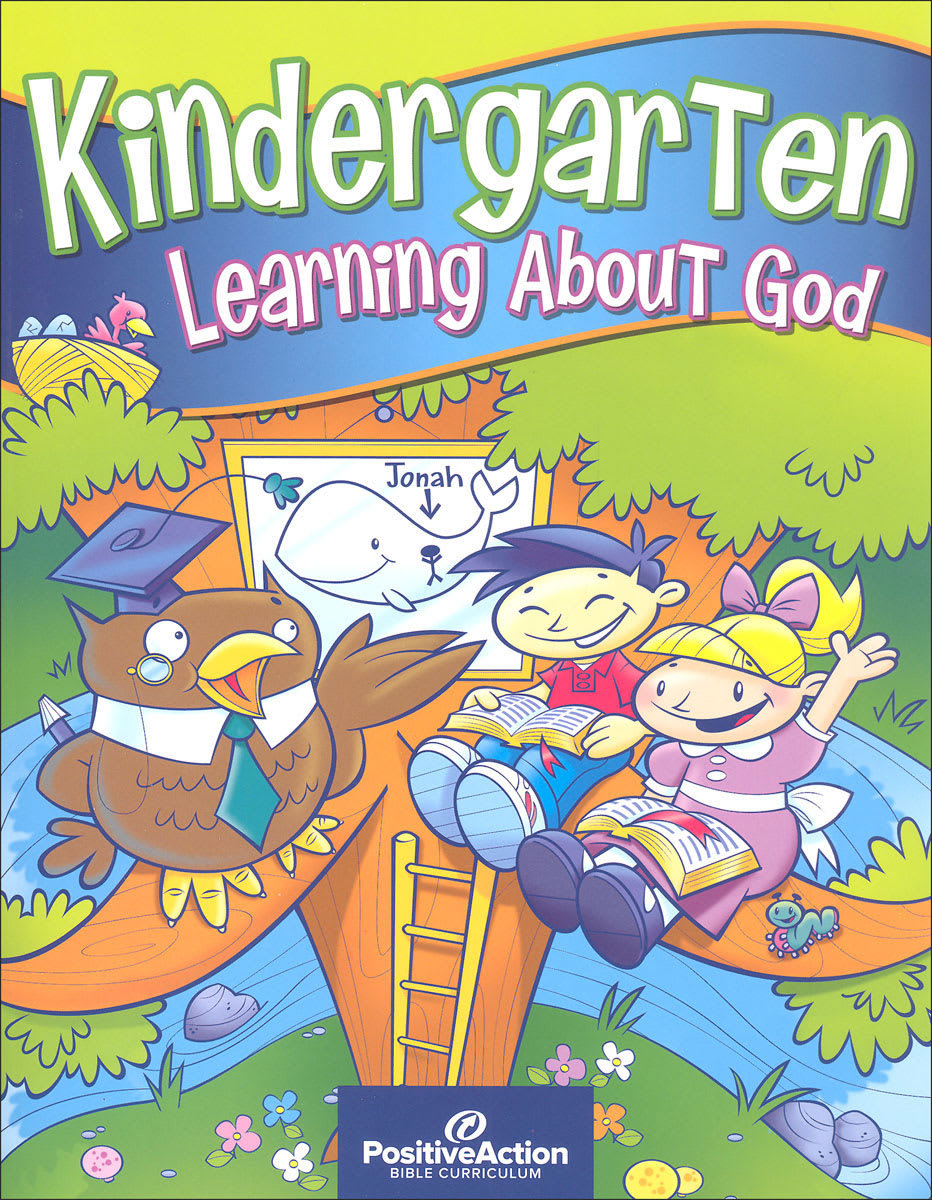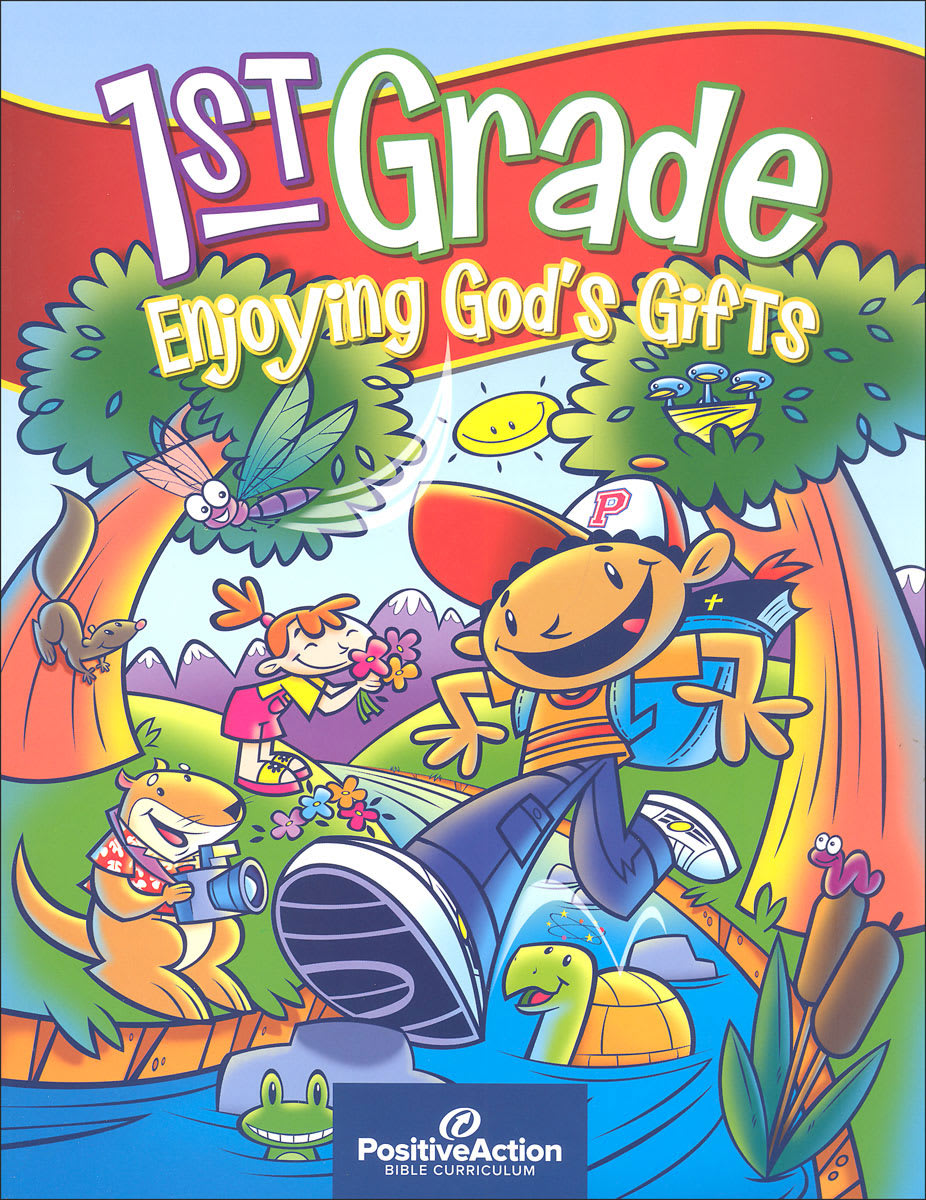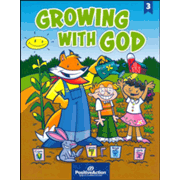Although Positive Action for Christ curriculum is written for the classroom, almost everything is easily adaptable for the homeschool. This is a “meaty,” non-denominational Bible-based curriculum with a strong emphasis on character development.
Courses for Grades K5-6
Grades K5-6 courses are all written by a single author, Cherie Noel. Noel is an excellent writer who knows how to construct interesting lessons. Consequently, each lesson consists of Bible reading, illustrative stories, discussion questions, character trait activities, hymns and choruses, Scripture memory, and seatwork with enough variety in learning style approaches to appeal to most learners. The courses can be used with your choice of Bible translations.
The bulk of each lesson is contained in the teacher’s manual, while a student workbook has activity pages (dot-to-dots, puzzles, fill-in-the-blanks, charts to complete, etc.) that reinforce lessons. Activities require increasing amounts of written work at upper levels, up to brief essay type answers. Six levels of thinking/processing—knowledge, comprehension, discernment, application, analysis, and evaluation—are built into lessons, even at the youngest levels. This means that lessons go beyond simple recall of facts to develop understanding and application of the subject matter. Student books are heavily illustrated and printed in full color.
Teacher’s manuals are available for all levels in either a loose-leaf, three-ring binder or as PDF files. Since the teaching comes primarily from the teacher’s manual, this is not an independent study curriculum, but one that requires teacher/parent involvement. However, a minimal amount of lesson preparation is required because the teacher’s manuals are so well-designed.
Each year of the curriculum contains thirty-five lessons (about one per week) developed around a unifying theme. (Different lesson plan options are suggested in the beginning of each teacher manual.)
Kindergartners are introduced to “the basics”--God’s character, Bible doctrines, and Scriptural principles. First graders learn about God’s gifts, including the gift of salvation. God’s promises are the topics for second grade. Christian growth is studied through the lives of Joseph and Daniel in third grade. Fourth grade is a survey of the New Testament, focusing on the life of Christ, the work of the Holy Spirit, and the apostle Paul. A survey of the Old Testament is presented in fifth grade. An athletic theme challenges sixth graders to put their Christian faith into action while focusing on a deeper study of God’s word and foundational doctrines. Because children (and adults) often need repetition before truly learning something, both character traits and Scripture verses are reviewed every few years in greater depth. Their detailed scope and sequence booklet shows developmental activities, “target truths,” God’s promises, and character traits covered in each lesson so you can easily choose the level that meets the needs of your child/children.
Both traditional hymns and choruses are incorporated into the curriculum. CD’s of hymns and choruses are available for those not familiar with those that are used. The publisher also sells Dr. Al Smith’s Treasury Of Hymn Histories, which briefly tells the story of each of the selected hymns and provides the sheet music. This adds an extra dimension of understanding as children learn the hymns. Sing and Be Happy is the music book for the choruses used in grades K5-6. Words to the hymns and choruses used are included at the end of each teacher manual as well as in student workbooks for grades 3-6, but you will need the two above-mentioned resources for the sheet music. A single CD for each grade also has all of the hymns and choruses.
By including character traits, thinking skills, and deeper music study, this curriculum attempts to be more comprehensive than most others for the elementary grades.
Grades 7-12
The Positive Action curriculum for junior/senior high level is “meatier” and more spiritually challenging than many others. Yet, there are suitable courses for all students. As with the elementary courses, it recognizes various levels of thinking skills and goes beyond simple recall of facts to develop understanding and application of knowledge. It also recognizes that teens are at different levels of spiritual growth with different courses to choose from for junior and senior high levels so that you can select that which best fits your teen’s need. Courses need not be used in a specific order. (They actually have more resources than those described here, but these would be great for starters.)
These courses each take a full school year to complete and have a teacher's manual and a student manual. Both are available in print or as PDFs. As with the younger levels, these studies are all dependent upon presentation from the teacher’s manuals. Visuals in the teacher's manual are used for class presentations, so the PDF for the teacher's manuals makes the most sense. More preparation and presentation time will be required for these upper-level courses.
Suggested schedules recommend some days be used for the teacher’s presentation of the lesson and others for student independent work. Student books are essential. They provide lesson information that reinforces and expands on the teaching presentation plus response activities. A moderate amount of writing is required. Most books are printed in two colors; The Life of Christ is in full color. (Newer editions have more attractive graphics and presentation with enhanced use of color.) Student books are designed to be written in, so they are not reusable.
One series for grades 7 through 12 assumes a more mature Christian walk, which is often the situation for home-educated students. The six courses in this series are challenging studies for students who are interested in spiritual growth. Dynamic Christian Living might well serve as the foundation for the remaining levels. (Start here if in doubt, even with older students.) The God-Man is designed to bring students to a deeper knowledge of the person of Jesus Christ through a study of the book of John. The Inner Man confronts students with the need to develop inner character rather than rely on the outward appearances of Christianity. The Christian Adventure, based on Pilgrim’s Progress, is an exciting study of the application of the classic allegory in our lives. The text of an “updated, youth-friendly” version of Pilgrim’s Progress is contained in the student book, The Christian Adventure. Behold Your God is designed to help students develop depth in their personal relationship with God. Teens study the principles of life as laid out in the book of Proverbs in a study called Proverbs. These studies could even be useful on an adult level; rather than simple, fill-in-the-blank courses, these are challenging, growth-provoking studies.
Wise Up! and Route 66, alternative courses for junior high level, both assume a lower level of spiritual maturity than the above courses. They assume that the teenager is struggling with typical issues—salvation, friends, obedience to parents, self-control, decision making, etc. The publisher tells me that Route 66 is their best selling study, and that it "is really enjoyed by students who have grown up in Sunday school and know the stories, but were missing how all the books fit together." The student books have written exercises, but most of them direct the student to Scripture rather than provide entertaining busy work. Wise Up! is subtitled “Wisdom in Proverbs.” Scripture study here ranges far beyond Proverbs, but it centers around “getting wisdom” in all areas of life. Route 66 is a Bible survey course with an emphasis on understanding God’s relationship with man throughout history. It moves chronologically from Genesis to Revelation, even covering the minor prophets. Either of these courses is easier than those described above, yet they are still spiritually challenging.
Change/Transforming Principles from the Beatitudes is another alternative written at a less challenging level that might be used by older students. It addresses internal spiritual changes through the study of Matthew 5:1-10. (This course is probably due for an updating on graphics and appearance. It looks dated compared to all the others.)
The Life of Christ targets grades 9 through 12. Through a study of the Gospel of John, students come to know the person of Jesus, particularly in his divinity. This course is suitable for a wide range of abilities and backgrounds. In its latest revision, it now has full color and plenty of maps, photos, and illustrations.
While some of the junior and senior high courses are neutral as to the Bible version, many of them (especially those with older copyrights) rely on the KJV.
Downloadable sample lessons are available on their website.
Also check out the supplemental writing resource In Their Sandals. This resource could be used at junior and senior high levels both to support scriptural lessons and develop composition skills.















